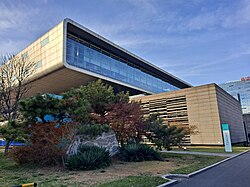| National Library of China | |
|---|---|
| 中国国家图书馆 | |
 National Library of China North Complex | |
 | |
| Location | Beijing, China |
| Type | National library |
| Established | September 1909 |
| Collection | |
| Size | 41 million (December 2020)[1] |
| Access and use | |
| Access requirements | Open to the public |
| Population served | 1.4 billion |
| Other information | |
| Director | vacant since April 2024 |
| Website | nlc.cn |
| National Library of China | |||||||||||
|---|---|---|---|---|---|---|---|---|---|---|---|
| Simplified Chinese | 中国国家图书馆 | ||||||||||
| Traditional Chinese | 中國國家圖書館 | ||||||||||
| |||||||||||
The National Library of China (NLC) is the national library of China, located in Haidian, Beijing, and is one of the largest libraries in the world. It contains over 41 million items as of December 2020.[1][2] It holds the largest collection of Chinese literature and historical documents in the world[3] and covers an area of 280,000 square meters.[4] The National Library is a public welfare institution funded by the Ministry of Culture and Tourism.
The collections of the National Library have inherited the royal collections since the Southern Song Dynasty and private collections since the Ming and Qing dynasties. The oldest collections can be traced back to the oracle bones of Yin Ruins more than 3,000 years ago.[5]
The National Library is a major research and public library, with items in 123 languages[6] and in many formats, both print and digital: books, manuscripts, journals, newspapers, magazines, sound and music recordings, videos, play-scripts, patents, databases, maps, stamps, prints, drawings. As of December 2020, the collection contains more than 41 million volumes and is growing at a rate of one million volumes per year.[7] The total amount of digital resources exceeds 1000TB and is growing at a rate of 100TB per year.[8]
The National Library of China was initially founded as the Imperial Peking Library by the Qing government in 1909. After several name changes and administrative alternation, it was renamed the National Library of China in 1999.[9] The National Library now consists of the South Complex, the North Complex, the Ancient Books Hall,[10] the Children's Hall, and seventeen dispatched research libraries to the central government's various departments and to the Academy of Military Sciences.[11][12]
- ^ a b "馆藏实体资源". National Library of China. 2018. Archived from the original on 27 February 2017. Retrieved 15 September 2018.
- ^ "Overview of Library Collections". National Library of China. Archived from the original on 9 December 2012. Retrieved 2 March 2017.
- ^ "The National Library of China (NLC) Advancing Towards the Twenty-first Century". National Library of Australia. Archived from the original on 5 June 2011.
- ^ Cite error: The named reference
:0was invoked but never defined (see the help page). - ^ "中国国家图书馆•中国国家数字图书馆——关于国图". www.nlc.cn. Archived from the original on 10 April 2022. Retrieved 10 April 2022.
- ^ "中国国家图书馆•中国国家数字图书馆——关于国图". National Library of China. Archived from the original on 10 April 2022. Retrieved 10 April 2022.
- ^ "中国国家图书馆•中国国家数字图书馆——关于国图". www.nlc.cn. Archived from the original on 10 April 2022. Retrieved 10 April 2022.
- ^ "中国国家图书馆•中国国家数字图书馆——关于国图". www.nlc.cn. Archived from the original on 10 April 2022. Retrieved 10 April 2022.
- ^ Bexin, Sun. "The Development of Authority Database in National Library of China" (PDF). National Institute of Informatics. Archived (PDF) from the original on 31 August 2021. Retrieved 5 March 2021.
- ^ "中国国家图书馆•中国国家数字图书馆". www.nlc.cn. Archived from the original on 20 February 2020. Retrieved 10 April 2022.
- ^ "隐身图书馆的"国家智库"——国家图书馆立法决策服务发展历程及成效". 嘉兴市文化广电新闻出版局. 9 October 2013. Archived from the original on 5 April 2017. Retrieved 10 April 2022.
- ^ "国家图书馆军事科学院分馆正式成立". www.mct.gov.cn. Retrieved 10 April 2022.